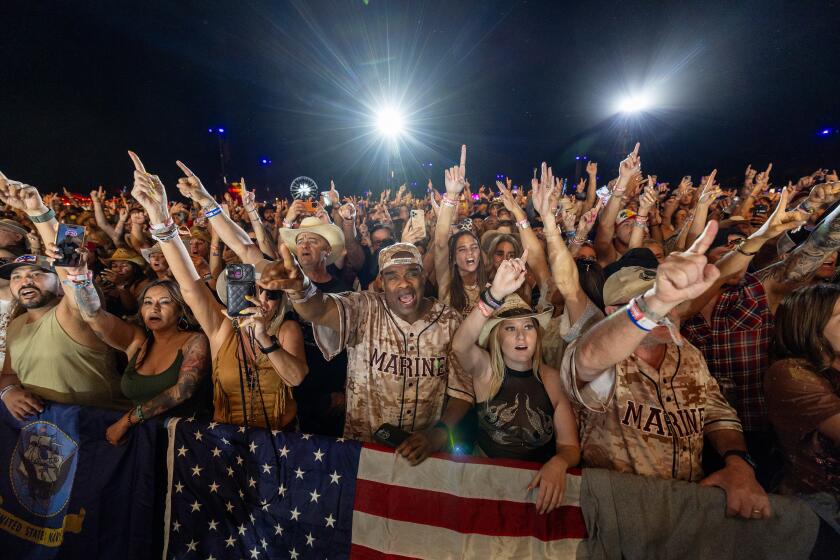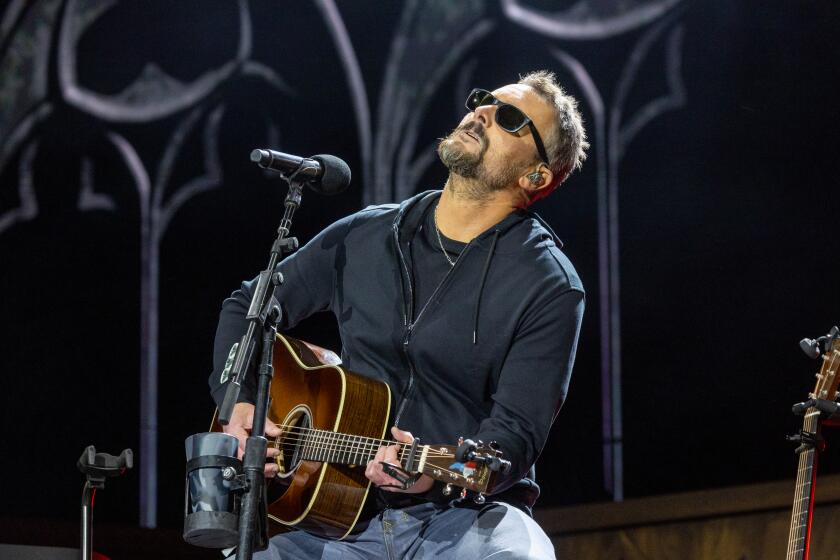MOCA’s ‘Art in the Streets’ gets the big picture wrong
Is graffiti the most influential art movement since Pop burst on the scene in 1962?
That’s the head-turning claim made by “Art in the Streets,” a controversial exhibition at the Museum of Contemporary Art. The show has been drawing the ire of social critics, alarmed by what they perceive as an institutional celebration of vandalism, all while drawing curious crowds (often young) to the museum’s Little Tokyo warehouse space. Graffiti is identified as a global artistic phenomenon that is thriving 40 years after it first emerged as a cultural marker around 1971.
The answer to the question depends not on moralizing interpretations, however, as the social critics want. Having lived in Hollywood for more than a dozen years in the 1980s and ‘90s, I’m pretty well convinced that urban graffiti doesn’t drag down neighborhoods, but instead erupts in areas already largely abandoned by civic forces. Graffiti scrawls a name on hitherto faceless social realities, instantly becoming a convenient target for blame.
Graffiti is a vernacular art. The remoteness of City Hall and the anonymity of socioeconomic power are confronted by in-your-face tagging, whose anarchic purpose is to register individual identity. In its crudest form it blurts, “I exist!” Its more imaginative forms also shout, “And I’m fantastic!”
Yes, graffiti is vandalism — a truism I know well from having repeatedly painted it out on my own former domicile. But what has that to do with MOCA? As critic William Poundstone pointedly asked, how many museum shows of El Greco are required to take a position on the Spanish Inquisition?
Still, MOCA’s claim for the magnitude of graffiti’s post-Pop influence on art is overblown. “Art in the Streets” cites global reach, including London; São Paolo, Brazil; Athens; and Tokyo, as evidence. (Sixty artists are surveyed.) Since the 1970s, however, the deepest impact on art culture has come from Conceptual art, not graffiti.
Conceptualism is the primary lingua franca of art today — like it or not, and for good or ill. Sixty artists couldn’t scratch the surface of its four-decade history. It operates the way Cubism did a century ago, its simultaneity of multiple viewpoints having given birth to Dada in the ‘teens and Surrealism in the ‘20s and dominated the 20th century’s first half. Now, Conceptual art even drives the materials of painting and sculpture that it once seemed poised to dissolve.
Remember Tom Wolfe’s nutty 1975 rant, “The Painted Word,” a slim volume claiming that theory had knocked visual experience to the ground and held it down for the count? One could even say that graffiti owes its 1980s emergence into art world consciousness to the success of Conceptual art’s frontal assault on formalist Modernism, with its crabbed notion that, say, a painting’s highest purpose is to define what a painting is. With an emphasis on words, some Conceptual art even opened the door to thinking of tagging as an artistic strategy.
Text in art was not novel; think Cubism again, with its fragments of newspapers and other collage elements. But in the ‘60s, Ed Ruscha’s big, blaring paintings of words or Lawrence Weiner’s typographic word-play written directly on gallery walls shifted the artistic role of language from subordinate to primary.
So “Art in the Streets” gets the big picture wrong — even though it does have much else to recommend it.
Perhaps the show’s most resonant feature is that it clarifies graffiti’s relationship to comics and cartoons. Like in the Pop art whose influence MOCA now claims street art has eclipsed, cartoon sensibilities are everywhere to be seen.
It’s there in some of the worst work, such as a jejune installation of an urban alley, complete with a corny mannequin of a heroin addict, by California artist Neck Face. It also dominates much of the best, including the famous chalk drawings that Keith Haring made on New York subway advertising panels and the woebegone “hangover heads” drawn by Barry McGee. Even the late Margaret Kilgallen’s marvelous monumental signage makes underground comics environmental.
Exploding cartoons to environmental scale is a street art staple. Cartoons and graffiti are both forms of mass art — not popular art, which is consumer-oriented, but mass art, which is hurled at anyone and everyone. Partly addressed to children, it exults in senselessness, as art critic Amy Goldin once noted. She identified mass art as intentionally irresponsible, demonic, fragmentary and nihilistic.
“Mass art addresses its audience from a madhouse,” Goldin wrote, “as inmate to inmate.” At MOCA, look at the sublime vulgarity of the low-rider ice cream truck spray-painted by Mister Cartoon, with its sexist busty-babes and leering metal-flake clowns, and you’ll know what Goldin means.
Graffiti is a visual wing of hip-hop. Its general cultural effect has been huge, including in fashion, video games, graphic design, advertising — even tattoos. (In 2006, the Pew Research Center estimated that 40% of Gen-Xers are tattooed.) Yet eloquence in the madhouse is rare, while inchoate raving is commonplace. Despite highlights, the show overflows with repetitive material, as if stuck in gear going on two generations now.
The sameness is wearying. And, sorry, but claiming that skateboarding is performance art, which this show does, is like saying “Keeping Up With the Kardashians” is TV theater. True, but emptily so.
So the biggest disappointment of “Art in the Streets” is its misunderstanding of history. That hits close to home.
Consider what doesn’t appear in the show — not even in the catalog chronology or the gallery’s information timeline.
Between 1969 and 1973, the L.A. Fine Arts Squad, led by Victor Henderson and Terry Schoonhoven, undertook an independent series of remarkable wall paintings around the city. During a period of Vietnam War disillusionment, they turned conventional expectations for commercial billboards into apocalyptic, free-for-all street visions.
In 1972 Willie Herrón, reacting to a gang assault on his brother, painted a wrenching mural in a City Terrace alley. He carefully incorporated the wall’s existing graffiti, expressly to insist on its equivalence with his painting.
That same year the Chicano artists’ collective Asco — Herrón, Gronk and Harry Gamboa Jr. — laid conceptual claim to the Los Angeles County Museum of Art by tagging the building the way a painter signs a canvas. Gamboa photographed Asco’s fourth member, Patssi Valdez, standing astride the bold graffiti.
The Squad’s work was the subject of a recent show at Culver City’s Cardwell Jimmerson Gallery. Photographic documentation of the LACMA tagging is in a survey of Latin American political art currently at Mexico City’s National Institute of Fine Arts. And an Asco retrospective opens at LACMA in September. But none of it is at MOCA.
Nor is any of the 1981 documentary “Mur Murs” by French director Agnes Varda, which chronicled much of the prior decade’s L.A. street art, including graffiti. “Mur Murs” is not included in the loop of “seminal film and video” playing at the show’s end.
About as far as it gets are paintings by L.A. artist Chaz Bojórquez, whose 1970s precedent in wall-stenciling reaches all the way to London’s Banksy today. Gusmano Cesaretti’s photographs of Chicano graffiti are also compelling. But East L.A. graffiti artist Gajin Fujita, whose distinctive paintings merging tagging with the “floating world” of traditional Japanese ukiyo-e are the most important 21st century iteration of graffiti’s influence on art (he shows regularly at L.A. Louvre), is nowhere to be found.
Mostly MOCA tells a mythic tale in which graffiti, an Expressionist art form, is largely born in Manhattan, spreads across the country and finally envelopes the world. If the story sounds familiar, that’s because it replays New York School legend, long since discredited, about Abstract Expressionist painting in the 1940s. The generative action has merely shifted from 10th Street and Greenwich Village, stamping ground of Pollock and De Kooning, to the South Bronx and the Lower East Side, hangouts of Crash and Kenny Scharf.
New York was certainly pivotal in marketing graffiti, starting in the 1980s, just as it was for Abstract Expressionism in the 1950s. In fact, that’s the real sequence leading from Pop art to street art. MOCA’s stylish exhibition mostly extends a legacy of commercial influence, which is the wrong way for an art museum to frame a show.
christopher.knight@latimes.com
More to Read
The biggest entertainment stories
Get our big stories about Hollywood, film, television, music, arts, culture and more right in your inbox as soon as they publish.
You may occasionally receive promotional content from the Los Angeles Times.







